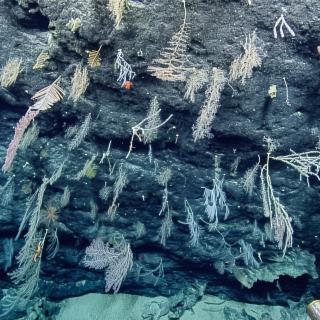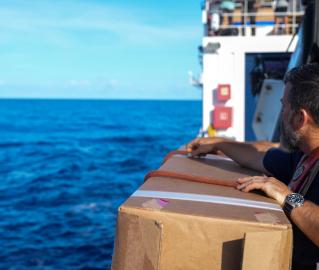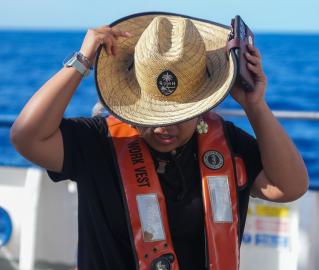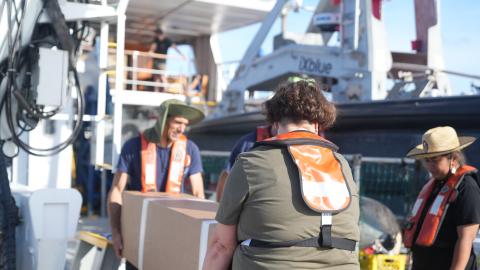Meet Ocean Explorer Swazi Gurnell

OET proudly welcomes Swazi Gurnell to the Corps of Exploration as part of the Science & Engineering Internship Program. This internship program supports community college, undergraduate, and graduate students in building professional workforce experience and exploring STEAM-related careers that connect to research themes like robotics, ocean science, education, and exploration. Swazi is joining E/V Nautilus for our NA172 expedition as a video engineering intern.
We sat with Swazi to learn more about his experience at sea and the path that led him to Nautilus.
Describe your role with OET.
I serve as a Video Systems Engineering Intern aboard E/V Nautilus. My role centers on documenting the cutting-edge science and exploration happening in real time. I’m responsible for maintaining all onboard camera systems—including those capturing shipboard life and those transmitting live footage from ROVs thousands of meters below the surface. In addition to upkeep and maintenance, I operate high-end video production tools such as the Ross Carbonite switcher, Cinedeck recording systems, and various capture and playback equipment that support live streaming and archiving. Each day, I get to contribute to telling the story of deep-sea exploration and making science accessible to viewers all over the world.
Can you tell us a little about your background? What influenced you as a child?
Back in high school, I took an Environmental Science course that introduced me to the critical importance of coral reefs. I was shocked to learn that coral reefs provide over 50% of the oxygen used by all living organisms, though they make up only about 0.0025% of the Earth’s surface. Even more alarming was learning that over 14% of coral reef populations have disappeared in just the past decade. That moment lit a fire in me and ignited me to do something about it. I wanted to use my passion for photography and filmmaking to advocate for science and environmental awareness, especially in communities that often don’t have access to this kind of information. Through the STEMSEAS program, I was introduced to the world of ocean exploration aboard the E/V Nautilus, and it completely changed my trajectory. I realized I could combine my love for visual storytelling with real-world science, which led me to pursue a path in science communication. Now, I’m committed to using my camera and voice to make science more accessible, engaging, and impactful for everyone.
When you were a kid, what did you want to be when you grew up?
As a child, I once told my mom that I wanted to travel the world, and my camera would be the reason for it. At the time I didn’t know what the career path would be, but I really enjoyed taking pictures of nature and capturing the stories of different kinds of people. I would say watching National Geographic and sometimes Anthony Bourdain with my Dad contributed to this passion as well.
What would you consider to be your greatest challenge entering this field?
One of the greatest challenges I’ve faced is simply not growing up near or around the ocean. As someone from suburban/urban Houston, Texas, I didn’t have direct access to marine environments or programs that introduced me to ocean science early on. My connection to the ocean came later through school, documentaries, and eventually programs like STEMSEAS and now OET. Because of that, I had to work harder to catch up on the knowledge and terminology that others may have been exposed to much earlier. It was intimidating at first being in conversations about ROVs, sonar mapping, and deep-sea ecosystems when it all felt so new to me. But I’ve realized that curiosity is just as valuable as experience. I might not have had early exposure, but I’ve always been eager to learn, ask questions, and step outside my comfort zone. That willingness to learn is what’s allowed me to grow quickly in this field and it’s what I hope to pass on to other students who may think science isn’t for them just because they haven’t “seen” it yet.
Do you have any advice for someone looking to follow a similar path?
My biggest piece of advice: don’t box yourself in. You don’t have to choose between science and art, or creativity and technical skills – you can do many combinations. I’m a photographer, a student-athlete, a ministry leader, and now a science communicator. I’ve learned that your unique combination of gifts is what makes you valuable. If you're starting out, look for programs like STEMSEAS, internships at organizations like the Ocean Exploration Trust, and community networks that support young people in STEM and media. There are a lot of these opportunities out there, you just have to apply – even if you think you're not ready. Also, don’t wait to be “professional” to start practicing. I started documenting church, school, and community events long before I ever touched broadcast equipment on a research vessel. That early experience trained my eye, built my confidence, and helped me understand storytelling in real time. Finally, be humble enough to learn and bold enough to lead. Ask questions, show up early, stay curious.
What’s next for your ocean studies and career?
After this expedition, I plan to continue pursuing science communication through both academic and creative channels. At Texas Southern University, I’m building a strong foundation in STEM while expanding my work as a storyteller. I also serve as the Media and Visual Arts Lead for the SUPERGirls SHINE Foundation, where I create dynamic visual content & digital storytelling to amplify the voices of young women in STEM. Long-term, I want to travel the world with scientists capturing their research and transforming it into powerful stories that resonate with everyday people, especially young audiences. Ultimately, I believe science becomes most impactful when it’s understood and felt. That’s my mission moving forward: to use media to bridge the gap between science, people, and the planet.

Exploring the Offshore Marianas
Update: Ongoing mechanical repair of a ship system has changed operational plans for the NA172 expedition, postponing the water column exploration and remotely operated vehicles portion of this expedition within the Mariana Trench Marine National Monument.





